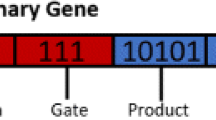Abstract
A feature-based fitness function is applied in a genetic programming system to synthesize stochastic gene regulatory network models whose behaviour is defined by a time course of protein expression levels. Typically, when targeting time series data, the fitness function is based on a sum-of-errors involving the values of the fluctuating signal. While this approach is successful in many instances, its performance can deteriorate in the presence of noise and/or stochastic behaviour. This paper explores a fitness measure determined from a set of statistical features characterizing the time series’ sequence of values, rather than the actual values themselves. Through a series of experiments involving modular gene regulatory network models based on the stochastic π-calculus, it is shown to successfully target oscillating and non-oscillating signals. This practical and versatile fitness function offers an alternate approach, worthy of consideration for use in algorithms that evaluate noisy or stochastic behaviour.
Similar content being viewed by others
References
Ando S., Sakamoto E., Iba H.: modeling and inference of gene network”. Information Sciences 145(3-4), 237–259 (2002)
Bar-Joseph Z.: “Analyzing time series gene expression data”. Bioinformatics 20(16), 2493–2503 (2004)
Blossey, R. and Cardelli, L. and Phillips, A.,“A Compositional Approach to the Stochastic Dynamics of Gene Networks,” Transactions on Computational Systems Biology IV, LNCS 3939, Springer Berlin/Heidelberg, pp. 99–122, 2006.
Blossey R., Cardelli L., Phillips A.: “Compositionality, Stochasticity and Cooperativity in Dynamic Models of Gene Regulation”. HFSP Journal 2(1), 17–28 (2008)
Borrelli A., De Falco I., Della Cioppa A., Nicodemi M., Trautteura G.: “Performance of genetic programming to extract the trend in noisy data series”. Physica A: Statistical and Theoretical Physics 370(1), 104–108 (2006)
Cardelli, L., “Abstract Machines of Systems Biology,” Transactions on Computational Systems Biology III, LNCS 3737, Springer, pp. 145–168, 2005.
Cho D.-Y., Cho K.-H., Zhang B.-T.: “Identification of biochemical networks by S-tree based genetic programming”. Bioinformatics 22(13), 1631–1640 (2006)
Chu, D., “Evolving Genetic Regulatory Networks for Systems Biology,” 2007 IEEE Congress on Evolutionary Computation (Srinivasan, D. and Wang, L. eds.), IEEE Press, pp. 875–882, 2007.
Dellaert, F. and Polzin, T. and Waibel, A., “Recognizing emotion in speech,” in Proc. of 4th International Conference on Spoken Language Processing, ICSLP 96, IEEE, pp. 1970–1973, 1996.
Drennan, B. and Beer, R. D., “Evolution of repressilators using a biologically-motivated model of gene expression,” Artificial Life X : Proc. of the Tenth International Conference on the Simulation and Synthesis of Living Systems, The MIT Press (Bradford Books), pp. 22–27, 2006.
Elowitz M.B., Levine A.J., Siggia E.D., Swain P.S.: “Stochastic Gene Expression in a Single Cell”. Science 297, 1183–1186 (2002)
Elowitz M.B., Leibler S.: “A synthetic oscillatory network of transcriptional regulators”. Nature 403, 335–338 (2000)
Fisher J., Henzinger T.A.: “Executable cell biology”. Nature Biotechnology 25(11), 1239–1249 (2007)
François P., Hakim V.: “Design of genetic networks with specified functions by evolution in silico”. Proc. of the National Academy of Science 101, 580–585 (2004)
Gagné C., Parizeau M.: “Genericity in Evolutionary Computation Software Tools: Principles and Case-study”. International Journal on Artificial Intelligence Tools 15(2), 173–194 (2006)
Gillespie D.T.: “Exact stochastic simulation of coupled chemical reactions”. Journal of Physical Chemistry 81(25), 2340–2361 (1977)
Guet C.C., Elowitz M.B., Hsing W., Leibler S.: “Combinatorial Synthesis of Genetic Networks”. Science 296(5572), 1466–1470 (2002)
Hinchliffe M.P., Willis M.J.: “Dynamic systems modelling using genetic programming”. Computers & Chemical Engineering 27(12), 1841–1854 (2003)
Imada, J., “Evolutionary Synthesis of Stochastic Gene Network Models using Feature-based Search Spaces,” MSc thesis, Brock University, Canada, 2009. http://www.cosc.brocku.ca/files/downloads/research/cs0910.pdf
Imada, J. H. and Ross, B. J., “Using feature-based fitness evaluation in symbolic regression with added noise,” GECCO ’08: Proc. of the 2008 GECCO conference companion on genetic and evolutionary computation, ACM, pp. 2153–2158, 2008.
Jin Y., Branke J.: “Evolutionary optimization in uncertain environments-a survey”. IEEE Transactions on Evolutionary Computation 9(3), 303–317 (2005)
Jin, Y. and Sendhoff, B., “Evolving in silico Bistable and Oscillatory Dynamics for Gene Regulatory Network Motifs,” in 2008 IEEE World Congress on Computational Intelligence (Wang, J. ed.), IEEE Press, pp. 386–391, 2008.
Kadous, M.W., “Learning comprehensible descriptions of multivariate time series,” in Proc. of the 16th International Conference on Machine Learning, Morgan Kaufmann, pp. 454–463, 1999.
Kikuchi S., Tominaga D., Arita M., Takahashi K., Tomita M.: “Dynamic modeling of genetic networks using genetic algorithm and S-system”. Bioinformatics 19(5), 643–650 (2003)
Kitagawa, J. and Iba, H., “Identifying metabolic pathways and gene regulation networks with evolutionary algorithms,” in Evolutionary Computing in Bioinformatics (Fogel, G. B. and Corne, D.W.), Morgan Kaufmann, pp. 255–278, 2002.
Koza, J. R., Mydlowec, W., Guido Lanza, G., Yu, J. and Keane, M. A., “Automatic Computational Discovery of Chemical Reaction Networks Using Genetic Programming,” in Computational Discovery of Scientific Knowledge (Dzeroski, S. and Todorovski, L. eds.), LNCS 4660, Springer, pp. 205–227, 2007.
Koza, J. R., Genetic Programming: On the Programming of Computers by Means of Natural Selection, The MIT Press, 1992.
Larrañaga P., Calvo B., Santana R., Bielza C., Galdiano J., Inza I., Lozano J.A., Armañanzas R., Santafé G., Martínez A.P., Robles V.: “Machine learning in bioinformatics”. Briefings in Bioinformatics 7(1), 86–112 (2006)
Leier, A. and Kuo, P. D., Banzhaf, W. and Burrage, K., “Evolving Noisy Oscillatory Dynamics in Genetic Regulatory Networks,” in Proc. of the 9th European Conference on Genetic Programming (Collet, P., Tomassini, M., Ebner, M., Gustafson, S. and Ekárt, A. eds.), LNCS 3905, Springer, pp. 290–299, 2006.
Leier, A. and Burrage, K.,“Evolving genetic regulatory networks performing as stochastic switches,” Artificial Intelligence and Simulation of Behaviour (AISB) Conference 2006: Adaptation in Artificial and Biological Systems (Kovacs, T. and Marshall, A. R. eds.), 3, Society for the Study of AI and Simulation of Behaviour, pp. 150–157, 2006.
Lewin, B., Genes IX, Jones and Bartlett, 2008.
Montana D.J.: “Strongly Typed Genetic Programming”. Evolutionary Computation 3(2), 199–230 (1995)
Moore, D. S., The Basic Practice of Statistics (3rd edition), W. H. Freeman and Company, 2004.
Nanopoulos, A., Alcock, R. and Manolopoulos, Y., “Feature-based classification of time-series data,” Information processing and technology, Nova Science Publishers, Inc., pp. 49–61, 2001.
Phillips, A., “The Stochastic Pi Machine (SPiM),” accessed at http://research.microsoft.com/en-us/um/people/aphillip/spim/index.html, 2008.
Poli, R. and Langdon, W. B. and McPhee, N. F., A field guide to genetic programming, published via http://lulu.com and freely available at http://www.gp-field-guide.org.uk, 2008.
Qian L., Wang H., Dougherty E.R.: “Inference of Noisy Nonlinear Differential Equation Models for Gene Regulatory Networks Using Genetic Programming and Kalman Filtering”. IEEE Transactions on Signal Processing 56(7), 3327–3339 (2008)
R Development Core Team, R: A Language and Environment for Statistical Computing, R Foundation for Statistical Computing, http://www.R-project.org, ver. 2.5.1, 2007.
Raj A., van Oudenaarden A.: “Nature, Nurture, or Chance: Stochastic Gene expression and Its Consequences”. Cell 135(2), 216–226 (2008)
Rodriguez-Vazquez K., Fleming P.J.: “Evolution of mathematical models of chaotic systems based on multiobjective genetic programming”. Knowledge and Information Systems 8(2), 235–256 (2005)
Rodríguez-Vázquez K., Fonseca C.M., Fleming P.J.: “Identifying the Structure of NonLinear Dynamic Systems Using Multiobjective Genetic Programming”. IEEE Transactions on Systems, Man, and Cybernetics—Part A: Systems and Humans 34(4), 531–545 (2004)
Ross, B. J., “Using Genetic Programming to Synthesize Monotonic Stochastic Processes,” Computational Intelligence (CI 2007) (Andonie, R. ed.), pp. 71–78, 2007.
Ross, B. J. and Imada, J., “Evolving Stochastic Processes Using Feature Tests and Genetic Programming,” GECCO ’09: Proc. of the 11th Annual conference on genetic and evolutionary computation, ACM, pp. 1059–1066, 2009.
Ross, B. J. and Imada, J., “Using multi-objective genetic programming to synthesize stochastic processes,” Genetic Programming Theory and Practice VII, Genetic and Evolutionary Computation, Springer US, pp. 159–175, 2010.
Sakamoto, E. and Iba, H.,“Inferring a System of Differential Equations for a Gene Regulatory Network by using Genetic Programming,” in Proc. of the 2001 Congress on EvolutionaryComputation CEC2001, IEEE Press, pp. 720–726, 2001.
Schwaerzel, R. and Bylander, T., “Predicting currency exchange rates by genetic programming with trigonometric functions and high-order statistics,” in GECCO ’06: Proc. of the 8th annual conference on Genetic and evolutionary computation (Cattolico, M. ed.), ACM, pp. 955–956, 2006.
Streichert, F., Planatscher, H., Spieth, C., Ulmer, H. and Zell, A., “Comparing Genetic Programming and Evolution Strategies on Inferring Gene Regulatory Networks,” in Genetic and Evolutionary Computation – GECCO-2004, Part I, Springer-Verlag, LNCS 3102, pp. 471–480, 2004.
Tkačik, G. and Bialek, W., “Cell biology: Networks, regulation, pathways,” arXiv/0712.4385, 2007.
Wang X., Smith K., Hyndman R.: “Characteristic-Based Clustering for Time Series Data”. Data Mining and Knowledge Discovery 13(3), 335–364 (2006)
Author information
Authors and Affiliations
Corresponding author
About this article
Cite this article
Imada, J., Ross, B.J. Evolutionary Synthesis of Stochastic Gene Network Models Using Feature-based Search Spaces. New Gener. Comput. 29, 365–390 (2011). https://doi.org/10.1007/s00354-009-0115-7
Received:
Revised:
Published:
Issue Date:
DOI: https://doi.org/10.1007/s00354-009-0115-7




